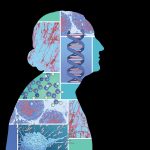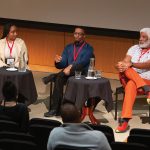Insights Jerry Sheehan Collaborating shoulder to shoulder with scientists
When you think about a person who heads an information technology department, you might not envision them working shoulder to shoulder with research scientists. But that’s exactly the approach Jerry Sheehan is taking as Salk’s new chief information officer (CIO).
Path to Salk
Sheehan’s career spans 30 years of information technology leadership, in which he has provided foundations for innovation and efficient user-centric service delivery in research- and education-focused environments. In addition to building partnerships, he is an expert in computational and data-intensive scientific research, cyberinfrastructure, data governance, and strategic planning.
Sheehan served most recently as vice president and CIO at San Diego State University, where he led the development and deployment of information technology infrastructure and services for research, instruction, and administration. Before San Diego State University, he served as vice president and CIO at Montana State University and in various leadership roles at the University of California San Diego/California Institute for Telecommunications and Information Technology (Calit2), Purdue University, and the National Center for Supercomputing Applications (NCSA).
When the CIO position at Salk became available, Sheehan says he pursued it because he saw it as a chance to be part of a scientific institution focused on helping to cure diseases—a motivation that was stoked by the recent loss of several close family members to various diseases.
“Working somewhere that expands understanding of the human condition and betters the world—it’s both humbling and invigorating,” says Sheehan, who assumed the role of CIO on December 4.
Working at Salk
Sheehan works closely with the president, chief science officer, and other senior administrative and scientific leaders to lead technology efforts across the Institute and drive digital innovation in support of the Institute’s leading-edge scientific research.
Sheehan sees his primary function as CIO as being a partner to researchers by helping to understand the IT needs of their scientific work.
“This role means you need to be a translator,” he says. “Translate the opportunities that exist to our scientists, while understanding their needs so we can develop software and deliver infrastructure that meets those needs.”
His first objectives were to talk with all of the labs at Salk and understand their research, and to work with his IT team to gain a better sense of potential opportunities and pain points. One of the things that struck him right away was the level of sophistication in the Institute’s IT infrastructure.
“Salk has a great technology foundation and facilities,” he says. “It’s a great advantage.”
Sheehan says he’s now focused on three key aims: First, to foster more collaboration by making sure that IT personnel understand the needs and road maps for scientific discoveries of the labs.
Second, guided by that understanding, he will approach the computer resources needs, weighing the pros and cons of traditional, on-site hardware that allows for flexibility, versus public and private clouds, which allow for quicker scalability.
His third point of emphasis is forging academic partnerships and leveraging public resources.
“Salk has always encouraged innovation,” he says. “We want to make these opportunities available across the campus in order to support Institute-wide innovation.”
Referencing what he has enjoyed most so far in his role, Sheehan says he appreciates the research-forward focus of his responsibilities, and the opportunity to learn more about groundbreaking science.
Life
Sheehan grew up in East Central Illinois, in a town named Pekin. He has two sisters, Kelly and Mary Jo. His childhood was quintessential small-town life—he knew everyone in town, and when not in school, would spend all day playing outside until his father whistled for him and his sisters to come home for dinner.
He was the first person in his family to attend college, earning his BS and MS degrees in political science at Eastern Illinois University. His family placed an emphasis on education, encouraging him to dedicate himself to his studies and take advantage of academic opportunities. A formative example was when Sheehan took up debate in the seventh grade. He enjoyed it so much that he competed all through high school and excelled to the point that his commitment was rewarded in the form of a full scholarship to college.
“The opportunity really opened doors for me, and also meant I spent significant time researching public policy issues.”
Sheehan lives with his partner, Dana, in South Park, San Diego.
Leisure Time
Sheehan’s favorite pastime is playing recreational tennis. He has played since high school. He later went on to take lessons to unlearn all the bad habits of play he had picked up in his youth. These days, he plays every weekend.
Fun Fact
If he hadn’t discovered the world of information technology, Sheehan says he was on the path to become a professor of political science.
What Lies Ahead
When asked what’s in store for his field, Sheehan says information technology is going through “a once-in-a-lifetime phase shift.” He explains there is a tremendous opportunity for innovation of the kind that hasn’t been seen since the advent of the internet. But its potential growth could be exponentially faster than that of the internet, thanks to machine learning and artificial intelligence.
Support a legacy where cures begin.
Featured Stories
 Interaction + Infrastructure = Innovations in Healthy AgingSalk formula recalculates aging research, shifting focus to overall resilience and health span.
Interaction + Infrastructure = Innovations in Healthy AgingSalk formula recalculates aging research, shifting focus to overall resilience and health span. Professor Jan Karlseder named Salk’s Chief Science OfficerOn February 1, Jan Karlseder started as Salk’s new senior vice president and chief science officer (CSO).
Professor Jan Karlseder named Salk’s Chief Science OfficerOn February 1, Jan Karlseder started as Salk’s new senior vice president and chief science officer (CSO).  Salk mourns the loss of Nobel Laureate Roger GuilleminThe Institute remembers the “father of neuroendocrinology” for his many contributions to science and friendship to all.
Salk mourns the loss of Nobel Laureate Roger GuilleminThe Institute remembers the “father of neuroendocrinology” for his many contributions to science and friendship to all. Daniel Hollern–Turning a cancer diagnosis into a career in basic researchAssistant Professor Daniel Hollern pivoted his career trajectory after a family member’s life-changing diagnosis pushed his already-curious mind off a cliff of questions—starting with, “What can I do to help him?”
Daniel Hollern–Turning a cancer diagnosis into a career in basic researchAssistant Professor Daniel Hollern pivoted his career trajectory after a family member’s life-changing diagnosis pushed his already-curious mind off a cliff of questions—starting with, “What can I do to help him?” Jerry Sheehan–Collaborating shoulder to shoulder with scientistsWhen you think about a person who heads an information technology department, you might not envision them working shoulder to shoulder with research scientists. But that’s exactly the approach Jerry Sheehan is taking as Salk’s new chief information officer (CIO).
Jerry Sheehan–Collaborating shoulder to shoulder with scientistsWhen you think about a person who heads an information technology department, you might not envision them working shoulder to shoulder with research scientists. But that’s exactly the approach Jerry Sheehan is taking as Salk’s new chief information officer (CIO). Laura Mainz–Taking control after a cancer diagnosisLaura Mainz grew up in a tiny village in midwestern Germany, with just as many cows as people. But the sweeping landscape speckled with farms never swayed her toward plant biology—instead, her interest in the human body grew.
Laura Mainz–Taking control after a cancer diagnosisLaura Mainz grew up in a tiny village in midwestern Germany, with just as many cows as people. But the sweeping landscape speckled with farms never swayed her toward plant biology—instead, her interest in the human body grew. Black Association affinity group cultivates welcoming environmentThe Black Association at Salk (BAS) was one of the first affinity groups formed at Salk in 2020. Since that time, it has established itself as a welcoming space and go-to for resources for all Black Salk community members.
Black Association affinity group cultivates welcoming environmentThe Black Association at Salk (BAS) was one of the first affinity groups formed at Salk in 2020. Since that time, it has established itself as a welcoming space and go-to for resources for all Black Salk community members.



















































